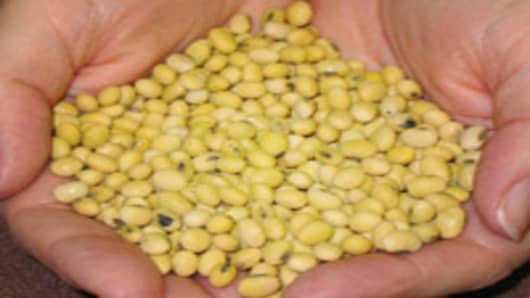A sharp increase in margin requirements for commodities contracts could slow trading and lower prices in the risk-driven market.
The Chicago Board of Trade announced Thursday that it was raising its margin requirements for trading in corn by 50 percent and in soybeans by 30 percent. Though margins--or the amount of cash needed upfront to initiate a trade--have been rising steadily, this is one of the largest increases to date.
The move comes as a reaction to the intense volatility in commodities trading and is aimed at helping traders avoid losing excessive amounts due to wild swings in the grain markets. Corn and soybeans both moved lower in morning trade.
Increasing margins is generally done to drive speculators out of the market because they're not willing to put up more cash to cover their trades.
As a practical matter, in corn the required margin posting for speculators went from $1,350 per contract to $2,025, and for hedge traders from $1,000 to $1,500. In soybeans, speculators must now post $4,388 per contract, up from $3,375, and hedge traders now must post $3,250, up from $2,500. In commodities, speculators trade futures contracts, while hedgers trade actual goods.
The margins move will be watched to see what effect it has on speculators, the group most responsible for driving the costs of various commodities.
"Using margins properly makes sense, but I will tell you in the present circumstance out in the grain industry, raising margins this materially is going to have a very deleterious impact," Dennis Gartman, publisher of the Gartman Letter, told CNBC.
"This is going to be a very tight circumstance and probably put downward pressure on grain prices today ... It is going to hamper the speculative fever in the grain market, no ifs, ands or buts about it."
But not everyone thinks the margin increase will have a major impact. Some believe the move will make the market a safer place to trade because of the cushion against loss, while the commodities trade remains strong with renewed dollar weakness.
"I honestly don't think it's going to have a huge impact," said Chris Nagel, market analyst at Northstar Commodity in Minneapolis.
"They've raised them pretty steadily. You might see something for a day or two where you take a few people out of the market that just can't handle it, but it just hasn't been that big of a factor."
In addition to the margin increases, CBOT also raised trading limits, or the amount in each direction that the price can swing before trading is halted. For corn, the limits went from 20 cents to 30 cents a bushel, while soybeans went from 50 cents to 70 cents.
In fact, raising the trading limit probably is what led to raising the margin limits, again to guard against large losses from speculators.
"I'm sure the two went together. If you're going to raise the limits, you have to raise the margin limits to cover the possibility of bigger moves," Nagel said.
Any reduced activity in commodities could benefit the stock market, as investors hesitant to post the extra cash for grain trading might be tempted to put it into equities.
Grain prices have surged in recent weeks as the dollar has weakened and global demand has increased dramatically for US agricultural products. But prices have been volatile lately as some analysts believe the stock market has reached or is near a bottom and now might be the time to return to stocks for better value.
In a related development, ConAgra Foods said it would sell its commodity tradingand merchandising operations in a deal valued at $2.1 billion, allowing it to focus on its core food business and to repurchase shares.


